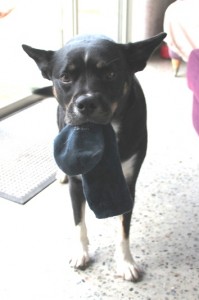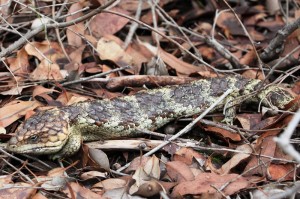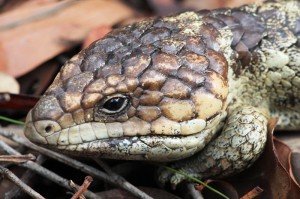Bobtail Lizard
 Shorty was my “donkey ears” today, teaching me to stop rushing and take time to stop and observe. We have a regular routine with at least 4 walks and she normally just sleeps when I am at my desk during the rest of the day. Occasionally she wants some more exercise or wants to play during and her trick is to go and find a sock then flap it around. She has me well trained as she looks so cute and imploring that I can’t ignore her. She came for me just after 1pm, so I went out with the camera, hoping to see more kangaroos. I found some orchids and Shorty found a blue tongued bobtail lizard.
Shorty was my “donkey ears” today, teaching me to stop rushing and take time to stop and observe. We have a regular routine with at least 4 walks and she normally just sleeps when I am at my desk during the rest of the day. Occasionally she wants some more exercise or wants to play during and her trick is to go and find a sock then flap it around. She has me well trained as she looks so cute and imploring that I can’t ignore her. She came for me just after 1pm, so I went out with the camera, hoping to see more kangaroos. I found some orchids and Shorty found a blue tongued bobtail lizard.
She is really good when she finds anything scaly and doesn’t go too close, she just stands in an excited pose with her head tilted and her tail up and wagging. Sometimes she yaps, if I don’t notice her, but I went over straight away to see what she had found. It is unusual to see a bobtail in winter as they normally stay inactive in an underground burrow. This one had obviously come out to bask in the sun. It looked thin, and didn’t move much. I stayed back so as not to frighten it and waste any of its energy. I have already seen the blue tongue on one of these lizards a couple of years ago in Spring, so I didn’t provoke it.
The bobtail lizards are one of the largest skinks in Australia. They can reach a length of 45 cm/18″ and can live for over 20 years. They generally pair bond and the female bobtails give birth to live young about four months after mating, usually between December and April. The embryos develop in the female’s oviduct with the help of a placenta, like a mammal, which the young eat after birth. The young are ready to look after themselves straight after birth, and disperse to live on their own within a few days.



Facebook